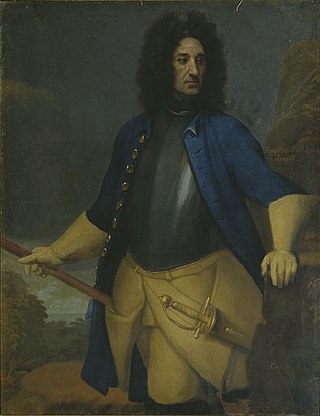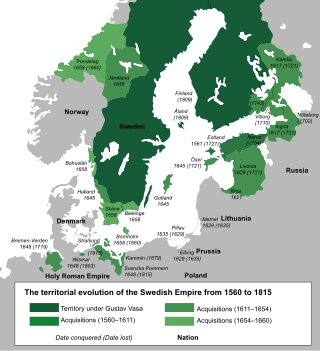Carl Baltzar von Dahlheim (1669-1756) was a German-Swedish military officer, born in Saxony as Baltzar Tahlheim, who distinguished himself serving Sweden during the Great Northern War.
Carl Baltzar von Dahlheim (1669-1756) was a German-Swedish military officer, born in Saxony as Baltzar Tahlheim, who distinguished himself serving Sweden during the Great Northern War.
After a short education, Dahlheim became a mercenary already as a teenager, participated in the battle of Vienna in 1683, and later in the English Glorious Revolution of 1688 under William III of Orange.
At the time of the outbreak of the Great Northern War, Dahlheim joined a Swedish regiment and distinguished himself as military engineer during Charles XII's campaign in Poland after the battle of Narva. At the battle of Poltava in 1709 Dahlheim was wounded but managed to follow Charles XII to Bendery where he spent over four years. In 1711 he was ennobled and took the name von Dahlheim.
After leaving Bendery Dahlheim was promoted to the rank of colonel and participated in the fighting around the fortress of Stralsund. He was severely wounded again, captured, and spent two years convalescing in captivity in Berlin. In 1718 he was released and appointed quartermaster general in Charles XII's army of Bohuslän in preparation of the king's second campaign against Norway. The latter came to an abrupt end with the death of the king at Fredrikssten.
In 1719 Dahlheim made his most renowned military achievement, as organizer and leader of the defence of Baggensstäket against the invading Russian skärgårdsflottan. With scarce resources, he succeeded holding his ground during the battle of Stäket, despite being severely wounded yet again, until reinforcements arrived.
After the battle of Stäke Dahlheim's career took a turn to the worse, and he was discharged under bad terms in 1722, at the age of 52. In 1723 he purchased the Stångberga estate i Vallentuna parish where he lived under meagre circumstances, earning his livelihood principally from agriculture. In 1748 he became the first recipient of the Order of the Sword, but could not wear the decoration since he had pawned his finest coat[ citation needed ].
Memorials attesting to the achievements of Dahlheim and others exist at Baggensstäket and Strömstad.

The Battle of Lesnaya was one of the major battles of the Great Northern War. It took place on October 9 [O.S. September 28] 1708 between a Russian army of between 26,500 and 29,000 men commanded by Peter I of Russia, Mikhail Mikhailovich Golitsyn, Aleksandr Danilovich Menshikov, Christian Felix Bauer and Nikolai Grigorovitj von Werden and a Swedish army of about 12,500 men commanded by Adam Ludwig Lewenhaupt and Berndt Otto Stackelberg, at the village of Lesnaya, located close to the border between the Polish–Lithuanian Commonwealth and Russia. The Swedes were escorting a supply column of more than 4,500 wagons for their main army in Ukraine.

Frederick I was King of Sweden from 1720 until his death, having been prince consort of Sweden from 1718 to 1720, and was also Landgrave of Hesse-Kassel from 1730. He ascended the throne following the death of his brother-in-law absolutist Charles XII in the Great Northern War, and the abdication of his wife, Charles's sister and successor Ulrika Eleonora, after she had to relinquish most powers to the Riksdag of the Estates and thus chose to abdicate. His powerless reign and lack of legitimate heirs of his own saw his family's elimination from the line of succession after the parliamentary government dominated by pro-revanchist Hat Party politicians ventured into a war with Russia, which ended in defeat and the Russian tsarina Elizabeth getting Adolf Frederick of Holstein-Gottorp instated following the death of the king. Whilst being the only Swedish monarch called Frederick, he was Frederick I of Hesse-Kassel and thus Frederick I also of Sweden, though other Swedish monarchs with non-repeating names had not been enumerated.

Charles XII, sometimes Carl XII or Carolus Rex, was King of Sweden from 1697 to 1718. He belonged to the House of Palatinate-Zweibrücken, a branch line of the House of Wittelsbach. Charles was the only surviving son of Charles XI and Ulrika Eleonora the Elder. He assumed power, after a seven-month caretaker government, at the age of fifteen.

The Battle of Poltava was the decisive and largest battle of the Great Northern War. A Russian army under the command of Tsar Peter I defeated a Swedish army, under the command of Carl Gustaf Rehnskiöld. The battle put an end to the status of the Swedish Empire as a European great power, as well as its eastbound expansion, and marked the beginning of Russian influence in Northern Europe.

Count Rutger von Ascheberg, also known as Roger von Ascheberg was a Swedish soldier, officer and civil servant who served as Lieutenant General in 1670, General in 1674, Field Marshal in 1678, Governor General of the Scanian provinces, in 1680, and Royal Councilor in 1681.

Peter Jansen Wessel Tordenskiold, commonly referred to as Tordenskjold, was a Norwegian nobleman and flag officer who spent his career in the service of the Royal Dano-Norwegian Navy. He rose to the rank of vice-admiral for his services in the Great Northern War. Born in the Norwegian city of Trondheim, Peter Wessel travelled to Copenhagen in 1704 and eventually enlisted in the navy.

Leopold I, Prince of Anhalt-Dessau was a German prince of the House of Ascania and ruler of the Principality of Anhalt-Dessau from 1693 to 1747. He was also a Generalfeldmarschall in the Prussian Army. Nicknamed "the Old Dessauer", he possessed good abilities as a field commander, but was mainly remembered as a talented drillmaster who modernized the Prussian infantry.
Stanisław Poniatowski was a Polish military commander, diplomat, and noble. Throughout his career, Poniatowski served in various military offices, and was a general in both the Swedish and Polish–Lithuanian militaries. He also held numerous civil positions, including those of podstoli of Lithuania and Grand Treasurer of the Lithuanian army in 1722, voivode of the Masovian Voivodeship in 1731, regimentarz of the Crown Army in 1728, and castellan of Kraków in 1752. Throughout his lifetime, he served in many starost positions.

Friedrich Wilhelm Freiherr von Bülow, Graf von Dennewitz was a Prussian general of the Napoleonic Wars.

Count Carl Gustav Rehnskiöld was a Swedish Field Marshal (fältmarskalk) and Royal Councillor. He was mentor and chief military advisor to King Charles XII of Sweden, and served as deputy commander-in-chief of the Carolean Army, an army he assisted both in its education and development.

The Crossing of the Düna took place during the Great Northern War on July 19, 1701 near the city of Riga, present-day Latvia. The Swedish king Charles XII was in hot pursuit of king Augustus II the Strong of the Polish–Lithuanian Commonwealth and Saxony. The crossing was easily made, and the coalition troops were quickly broken and retreated.

Carl Gustaf Armfeldt was a Swedish officer, general and friherre (baron) who took part in the Great Northern War.

Axel Erik Roos was a baron, lieutenant general in the Swedish army of Charles XII of Sweden, and governor of Dalsland.

The Swedish Empire was the period in Swedish history spanning much of the 17th and early 18th centuries during which Sweden became a European great power that exercised territorial control over much of the Baltic region. The beginning of the period is usually taken as the reign of Gustavus Adolphus, who ascended the throne in 1611, and its end as the loss of territories in 1721 following the Great Northern War.

The Battle of Krasnokutsk–Gorodnoye took place on February 20–22, 1709, in the Swedish campaign of Russia during the Great Northern War. The Swedish troops were directly led by Charles XII King of Sweden who pursued a force of Russians commanded by Otto Rudolf von der Schaumburg from the minor battle of Krasnokutsk to the town Gorodnoye where a new battle took place, with the Russians now commanded by Karl Evald von Rönne. The Swedes were victorious but cancelled their offensive when the night fell.
The Battle of Darsūniškis took place on March 24, 1702 near the town of Darsūniškis during the Swedish invasion of Poland in the Great Northern War. The Swedish army of about 240 men under the command of Alexander Hummerhielm was defeated by the Polish–Saxon army of 6,000 men under Michał Serwacy Wiśniowiecki.
The Battle of Varja took place on November 7, 1700, close to the villages of Varja and Aa, in the Duchy of Estonia of the Swedish Empire during the Estonian campaign of the first year in the Great Northern War.

Count Carl Gustaf Dücker was a Swedish field marshal (Fältmarskalk) and Royal Councillor.

The Drabant Corps of Charles XII was the most prestigious unit in the Swedish Army during the time of the Great Northern War. As a result of the reforms of 1700, all personnel in the corps received an officer's rank with increased wages, while its size was eventually set at 168 men. Those serving as Drabants were almost exclusively recruited from the Swedish Empire, with most coming from Sweden. The corps was issued the finest weapons, horses, and clothing was often adorned with gold lacing. They fought according to the cavalry regulations of the Caroleans, emphasizing the cold-steel charge in slight wedge formations, knee behind knee, over the more common caracole. This strategy allowed them to function as a bodyguard for the king as well as an elite combat unit, often playing a crucial role in the battles despite their relatively small size. During the war, the corps frequently marched with the main army and the king, fighting in most battles.

The Great Northern War in Ukraine (1708–1713) — war between the Tsardom of Russia on one hand and the Swedish Empire and the Ottoman Empire on the other.